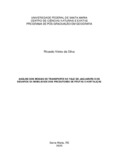| dc.creator | Silva, Ricardo Vieira da | |
| dc.date.accessioned | 2021-06-23T21:10:03Z | |
| dc.date.available | 2021-06-23T21:10:03Z | |
| dc.date.issued | 2020-01-30 | |
| dc.identifier.uri | http://repositorio.ufsm.br/handle/1/21205 | |
| dc.description.abstract | Geographical science seeks to describe, analyze and understand geographical space. Its need is due to the interrelationships and human interactions. By appropriating the environment, man begins to produce both goods and services and objects in order to meet his needs. Consequently, by interacting with the environment, society, as a rule, starts to be impacted by the conditions/restrictions it presents. In this context, the present study had as a general objective, to characterize the influence of geomorphological and structural elements that condition (limit/potentialise) the mobility of horticulturalists in the municipalities of Santiago, Nova Esperança do Sul and Jaguari, members of the Jaguari Valley, Rio Grande do Sul. A series of computational tools contained in the Geographic Information Systems were applied, with emphasis on the free software QGIS version 3.4 LTR "Madeira", where a series of routines and spatial analyses were carried out in order to better understand the study area. Adding to the fieldwork done in September 2018/2019, they are essential for a better understanding of the processes working on rural roads. As for the results reported, initially an analysis of horticultural production was made, as a way to obtain subsidies that would justify the demand for transportation. It was observed that in the period of 12 years between 2006 and 2018, there was an increase of 4.76% in horticultural production, from 4,667.00 to 4,889.00 tons, between 2006 and 2018, thus justifying the need for a modal capable of meeting such needs. On the other hand, it was observed that almost 80% of the roads in the respective municipalities are unpaved, suffering from holes, erosion, absence of drainage, etc. Geomorphological analyses, on the other hand, show that they affect, restrict/condition the trafficability of rural roads, affecting mobility both for agricultural production, especially horticultural production, and for those who indirectly depend on the road system as a whole. | eng |
| dc.description.sponsorship | Coordenação de Aperfeiçoamento de Pessoal de Nível Superior - CAPES | por |
| dc.language | por | por |
| dc.publisher | Universidade Federal de Santa Maria | por |
| dc.rights | Attribution-NonCommercial-NoDerivatives 4.0 International | * |
| dc.rights.uri | http://creativecommons.org/licenses/by-nc-nd/4.0/ | * |
| dc.subject | Fruticultura | por |
| dc.subject | Estradas rurais | por |
| dc.subject | Geomorfologia | por |
| dc.subject | Geotecnologias | por |
| dc.subject | Fruticulture | eng |
| dc.subject | Rural roads | eng |
| dc.subject | Geomorphology | eng |
| dc.subject | Geoprocessing | eng |
| dc.title | Análise dos modais de transporte no Vale do Jaguari/RS e os desafios da mobilidade dos produtores de frutas e hortaliças | por |
| dc.title.alternative | Analysis of transport modals in the Jaguari/RS Valley and the challenges of mobility of fruit and vegetable producers | eng |
| dc.type | Dissertação | por |
| dc.description.resumo | A ciência geográfica procura descrever, analisar e entender o espaço geográfico. Sua necessidade se dá em virtude das inter-relações e interações humanas. Ao apropriar-se do meio ambiente, o homem passa a produzir tanto bens e serviços como objetos a fim de suprir suas necessidades. Consequentemente, ao interagir com o meio a sociedade, via de regra, passa a ser impactada pelas condições/restrições que o mesmo apresenta. Nesse contexto, o presente estudo teve como objetivo geral, caracterizar a influência dos elementos geomorfológicos e estruturais que condicionam (limitam/potencializam) a mobilidade dos hortifruticultores nos municípios de Santiago, Nova Esperança do Sul e Jaguari, integrantes do Vale do Jaguari, Rio Grande do Sul. Buscou-se aplicar uma série de ferramentas computacionais contidas nos Sistemas de Informações Geográficas, com ênfase no software livre QGIS versão 3.4 LTR “Madeira”, onde uma serie de rotinas e análises espaciais, foram realizadas com o intuito de melhor compreender a área de estudo. Somando-se aos trabalhos de campo realizado no mês de setembro de 2018/2019, sendo imprescindíveis para uma melhor compreensão dos processos atuantes sobre as estradas rurais. Quanto aos resultados reportados, inicialmente se fez uma análise da produção hortifrutícola, como forma de se obter subsídios que se justificasse a demanda por transportes. Observou-se que no período de 12 anos entre 2006 a 2018, houve um aumento de 4,76% na produção hortifrutícola, passando de 4.667,00 para 4.889,00 toneladas, entre 2006 a 2018, justificando assim a necessidade de um modal capaz de satisfazer tais necessidades. Por outro lado, observou-se que, praticamente 80% das estradas nos respectivos municípios não são pavimentadas, sofrendo com buracos, erosões, ausência de drenagem, etc. Já as análises geomorfológicas evidenciam que os mesmos afetam, restringem/condicionam a trafegabilidade das estradas rurais, afetando a mobilidade tanto para escoar a produção agrícola, em especial a da hortifruticultura como para aqueles que indiretamente dependem do sistema viário como um todo. | por |
| dc.contributor.advisor1 | Trentin, Romario | |
| dc.contributor.advisor1Lattes | http://lattes.cnpq.br/2287005710639329 | por |
| dc.contributor.referee1 | Viera, Valmir | |
| dc.contributor.referee2 | Cirolini, Angélica | |
| dc.creator.Lattes | http://lattes.cnpq.br/9481326162995348 | por |
| dc.publisher.country | Brasil | por |
| dc.publisher.department | Geografia | por |
| dc.publisher.initials | UFSM | por |
| dc.publisher.program | Programa de Pós-Graduação em Geografia | por |
| dc.subject.cnpq | CNPQ::CIENCIAS HUMANAS::GEOGRAFIA | por |
| dc.publisher.unidade | Centro de Ciências Naturais e Exatas | por |



